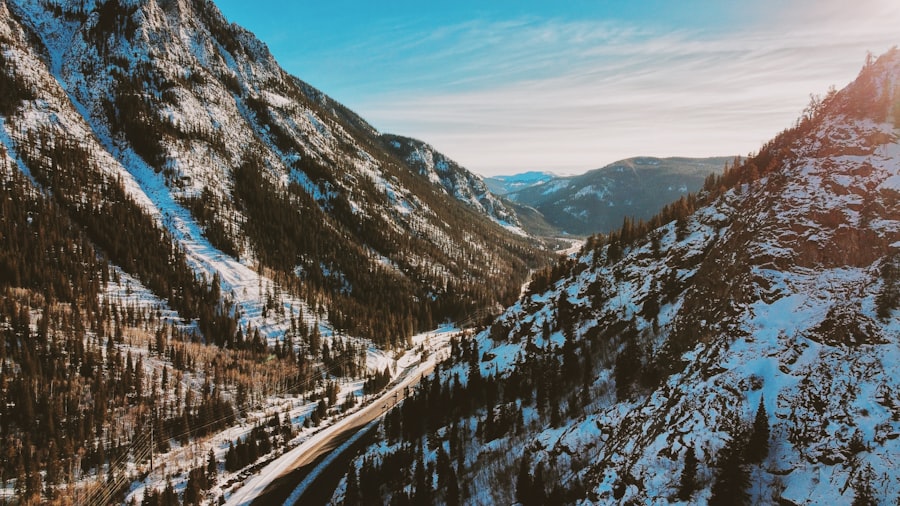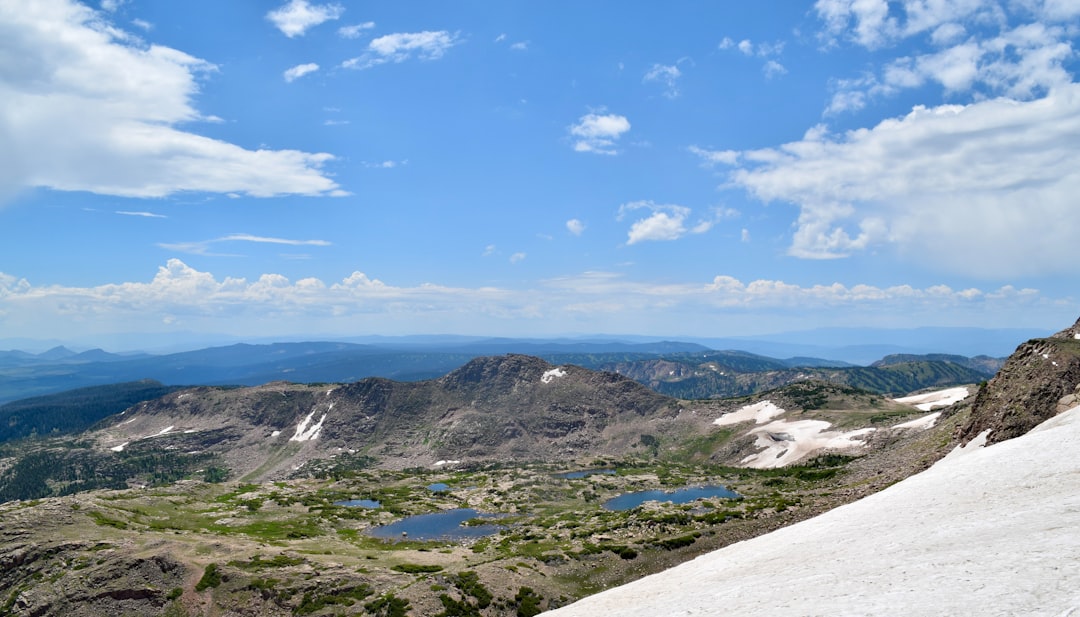The Continental Divide, often referred to as the Great Divide, is a significant hydrological feature that runs through North America, delineating the watersheds that drain into the Pacific Ocean from those that flow into the Atlantic Ocean and the Arctic Ocean. This natural boundary stretches from the northern reaches of Canada, traversing the Rocky Mountains, and extending down to New Mexico. The Divide is not merely a line on a map; it represents a complex interplay of geography, ecology, and hydrology that has profound implications for the continent’s water systems.
In essence, the Continental Divide serves as a watershed divide, meaning that any precipitation that falls on one side of the Divide will eventually flow toward one ocean, while precipitation on the other side will flow toward a different ocean. This phenomenon is crucial for understanding the distribution of water resources across North America. The Divide is marked by rugged terrain, towering peaks, and breathtaking landscapes, making it not only a geographical landmark but also a site of immense natural beauty and ecological diversity.
Key Takeaways
- The Continental Divide is a natural boundary that separates the direction of water flow on the North American continent.
- The geographical significance of the Continental Divide lies in its role in determining the flow of rivers and the division of watersheds.
- The Continental Divide affects weather patterns by influencing the distribution of precipitation and the formation of climate zones.
- The Continental Divide’s impact on ecosystems is significant, as it creates distinct habitats and influences the distribution of flora and fauna.
- The Continental Divide acts as a natural barrier, affecting the movement of wildlife and shaping human settlement patterns.
The geographical significance of the Continental Divide
The geographical significance of the Continental Divide extends beyond its role as a watershed. It serves as a defining feature of the North American landscape, influencing not only hydrology but also climate and biodiversity. The Divide runs through some of the continent’s most iconic mountain ranges, including the Rockies, which are characterized by their dramatic elevations and varied ecosystems.
This topographical prominence creates distinct climatic zones on either side of the Divide, leading to diverse habitats that support a wide array of flora and fauna. Moreover, the Continental Divide plays a crucial role in shaping regional geography. It affects river systems, creating major waterways such as the Colorado River and the Missouri River, which originate on opposite sides of the Divide.
These rivers are vital for irrigation, recreation, and wildlife habitats. The geographical features associated with the Continental Divide also attract tourists and outdoor enthusiasts, contributing to local economies and fostering a connection between people and nature.
How the Continental Divide affects weather patterns

The Continental Divide significantly influences weather patterns across North America. Its towering peaks act as barriers to prevailing winds, causing variations in precipitation and temperature on either side. For instance, areas to the west of the Divide often experience wetter conditions due to moist air masses from the Pacific Ocean being forced upward, resulting in orographic lift and increased rainfall.
In contrast, regions to the east tend to be drier, as these air masses lose moisture before descending into the interior plains. This phenomenon creates distinct climatic zones that can vary dramatically over short distances. The western slopes of the Rockies are lush and green, while the eastern slopes may transition into arid deserts or grasslands.
Such variations in weather patterns not only affect local ecosystems but also have implications for agriculture, water supply, and even urban planning. Understanding these dynamics is essential for managing resources effectively in regions influenced by the Continental Divide.
The Continental Divide’s impact on ecosystems
| Impact on Ecosystems | Metrics |
|---|---|
| Changes in biodiversity | Species richness, population density |
| Water distribution | Water availability, stream flow |
| Vegetation patterns | Plant species composition, forest structure |
| Wildlife habitat | Migration routes, nesting areas |
The ecosystems along the Continental Divide are as diverse as they are complex. The varying elevations and climatic conditions create a mosaic of habitats that support an array of plant and animal species. From alpine tundra at higher elevations to dense forests at lower altitudes, each ecosystem plays a vital role in maintaining biodiversity.
Species such as mountain goats, elk, and various bird species thrive in these unique environments, relying on specific conditions for their survival. Furthermore, the Continental Divide acts as a natural corridor for wildlife migration. Animals often traverse this boundary in search of food, mates, or suitable habitats.
However, human activities such as urban development and road construction can disrupt these migratory patterns, posing challenges for conservation efforts. Protecting these ecosystems is crucial not only for preserving biodiversity but also for maintaining the ecological balance that sustains life along this significant geographical feature.
The Continental Divide as a natural barrier
As a natural barrier, the Continental Divide has historically influenced human settlement patterns and cultural development across North America. Its rugged terrain presents challenges for transportation and communication, leading to distinct regional identities on either side of the Divide. The mountains have served as both obstacles and gateways; while they hindered early explorers and settlers from crossing easily, they also provided routes for trade and migration.
The Divide’s role as a natural barrier extends beyond physical geography; it has also shaped social and political boundaries. Different cultures have emerged on either side of the Divide, influenced by varying access to resources and environmental conditions. This division has contributed to a rich tapestry of cultural diversity in North America, with each region developing its own unique traditions and ways of life.
Human interaction with the Continental Divide

Human interaction with the Continental Divide has evolved over centuries, reflecting changing attitudes toward nature and resource management. Indigenous peoples have long revered this landscape, utilizing its resources sustainably while maintaining a deep spiritual connection to the land. Their knowledge of the ecosystems along the Divide has been invaluable in understanding how to live harmoniously with nature.
In contrast, European settlers viewed the Continental Divide primarily as a barrier to be conquered and exploited. The quest for land and resources led to extensive logging, mining, and agriculture in these regions. While such activities contributed to economic growth, they also resulted in significant environmental degradation.
Today, there is a growing recognition of the need for sustainable practices that honor both human needs and ecological integrity along this vital geographical feature.
The Continental Divide’s role in water resource management
Water resource management is intricately linked to the Continental Divide’s hydrological significance. As a watershed boundary, it dictates how water flows across vast regions, impacting everything from agriculture to urban development. Understanding this relationship is essential for effective water management strategies that ensure equitable distribution and conservation of this precious resource.
In recent years, challenges such as climate change and population growth have intensified pressure on water resources in areas influenced by the Continental Divide. Droughts and changing precipitation patterns threaten water availability for both human consumption and agricultural needs.
The Continental Divide and its influence on transportation
Transportation across the Continental Divide has historically posed challenges due to its rugged terrain. Early explorers relied on footpaths or horseback to navigate these mountains, while modern infrastructure has evolved to include highways and railroads that traverse this formidable landscape. However, even with advancements in technology, crossing the Divide remains an undertaking that requires careful planning and consideration of environmental impacts.
The influence of the Continental Divide on transportation extends beyond logistics; it shapes economic connections between regions. Major highways that cross the Divide facilitate trade and tourism, linking communities on either side of this natural barrier. However, these routes also raise concerns about habitat fragmentation and pollution.
Balancing transportation needs with ecological preservation is an ongoing challenge that requires innovative solutions.
The Continental Divide’s role in shaping American history
The Continental Divide has played a pivotal role in shaping American history from early exploration to contemporary environmental movements. It served as a formidable barrier for pioneers seeking new opportunities in the West during westward expansion in the 19th century. The challenges posed by this natural feature influenced settlement patterns and economic development across vast territories.
Moreover, significant historical events have unfolded along or near the Continental Divide. The Lewis and Clark Expedition famously traversed parts of this landscape in their quest for knowledge about the western territories. Their journey not only contributed to scientific understanding but also paved the way for future exploration and settlement.
Today, this historical legacy continues to resonate as communities strive to honor their connection to this remarkable geographical feature.
Conservation efforts and the Continental Divide
Conservation efforts along the Continental Divide have gained momentum in recent years as awareness grows regarding environmental challenges facing this unique landscape. Various organizations and government agencies are working collaboratively to protect critical habitats, restore ecosystems, and promote sustainable land use practices. These initiatives aim to preserve biodiversity while ensuring that future generations can enjoy the natural beauty of this region.
One notable example is the establishment of protected areas such as national parks and wilderness areas along the Divide. These designations help safeguard vital ecosystems from development pressures while providing opportunities for recreation and education. Additionally, community engagement plays a crucial role in conservation efforts; local residents often serve as stewards of their environment, advocating for policies that prioritize ecological health alongside economic interests.
The future of the Continental Divide and its importance in the face of climate change
As climate change continues to pose unprecedented challenges globally, the future of the Continental Divide remains uncertain yet critically important. Rising temperatures, altered precipitation patterns, and increased frequency of extreme weather events threaten both ecosystems and human communities reliant on this landscape for resources. Understanding how these changes will impact water availability, biodiversity, and regional economies is essential for effective adaptation strategies.
Looking ahead, proactive measures must be taken to mitigate climate change impacts along the Continental Divide. This includes investing in sustainable practices that enhance resilience within ecosystems while promoting responsible land use among communities. By fostering collaboration among stakeholders—ranging from government agencies to local residents—there is potential to create a more sustainable future that honors both human needs and ecological integrity along this vital geographical feature.
In conclusion, the Continental Divide stands as a remarkable testament to nature’s power while serving as a critical component of North America’s hydrology, ecology, history, and culture. Its significance extends far beyond mere geography; it shapes weather patterns, influences ecosystems, acts as a natural barrier, impacts transportation routes, informs water resource management strategies, and plays an essential role in conservation efforts amid climate change challenges. As society navigates these complexities moving forward into an uncertain future—understanding our relationship with this extraordinary landscape will be paramount for ensuring its preservation for generations yet unborn.
The Continental Divide plays a crucial role in shaping the geography and climate of North America, acting as a natural barrier that influences weather patterns and water flow across the continent. This divide, which runs from Alaska through the Rocky Mountains and down into Central America, helps protect the eastern and western parts of the United States from extreme weather conditions by directing the flow of moisture-laden air masses. For a deeper understanding of how the Continental Divide impacts America’s natural environment, you can explore this related article that delves into its geographical significance and protective features.
WATCH THIS! The Hidden Reason No One Can Invade America | A Geographical Analysis
FAQs
What is the Continental Divide?
The Continental Divide is a natural boundary line that runs along the spine of the Rocky Mountains, separating the watersheds that drain into the Pacific Ocean from those that drain into the Atlantic Ocean.
How does the Continental Divide protect America?
The Continental Divide acts as a natural barrier, helping to protect America from potential threats and providing a strategic advantage in defense and security.
What are some of the ways the Continental Divide provides protection?
The rugged terrain and difficult terrain of the Continental Divide make it challenging for potential invaders to cross, providing a natural defense against military threats.
Does the Continental Divide have any impact on weather patterns and climate?
Yes, the Continental Divide plays a role in shaping weather patterns and climate by influencing the direction of water flow and the distribution of precipitation across the continent.
Are there any environmental benefits to the Continental Divide?
Yes, the Continental Divide helps to maintain the ecological balance by preserving distinct ecosystems and habitats on either side of the divide. It also contributes to the conservation of natural resources and biodiversity.
